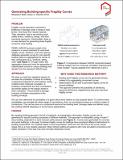Research Brief: Generating Building-specific Fragility Curves
Author(s)
Mulla, Talal; Pellenq, Roland; Ulm, Franz-Josef
DownloadFragility_Curves_Research_Brief_2019.pdf (938.3Kb)
Metadata
Show full item recordAbstract
Fragility curves represent a structure’s likelihood of damage under a range of load levels—like those from natural hazards. They, therefore, help to set building code safety factors, resiliency ratings, and even insurance premiums. Unfortunately, there is no real standard for generating these fragility curves for wind loading. FEMA’s HAZUS hurricane model is the closest to a current standard for wind-load fragility curves. However, even this rigorous database generates curves for only specific building types by aggregating the curves of their components (e.g., windows, siding, roof) (see Figure 1). Though useful, this aggregation approach limits the generation of customizable curves for unique buildings that deviate from the standard HAZUS types.
Date issued
2019-05Series/Report no.
MIT CSHub Research Brief; Volume 2019, Issue 4
Keywords
Resilience, Structural Mechanics, Fragility Curves, Structural Engineering, Climate Change